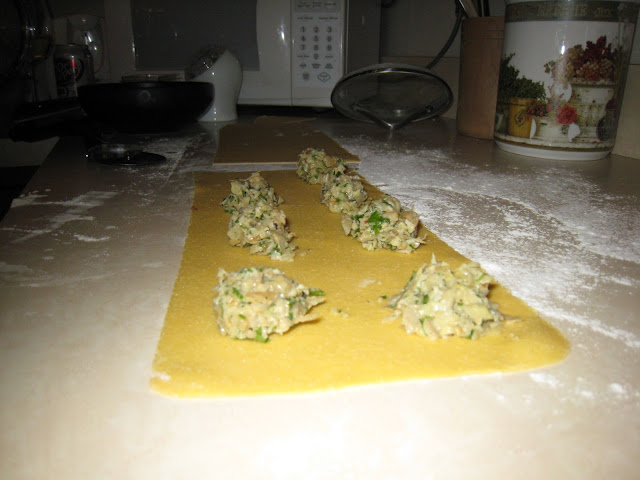I'm not sure what it is about black bean soup, but my dad and I both seem to really enjoy it. Maybe because we're Italian and it's a latin thing, or maybe because it's rich, fairly healthy, and not overly pungent. A good black bean soup, to me, has a nice backbone of garlic and spices, but isn't overwhelming in any way. It's served warm but not hot, and it's not pushy what you do with it - you can eat it as a dish or as a side. It just exists to make you happy, which this recipe did for me.
I found a recipe for a basic black bean soup, but it called for canned beans. And I wanted to start from scratch, using staples common to latin america that I knew I could keep for a while and pull out of storage at a moment's notice down the road. So I made my version from dried beans, which requires some advance planning. It also calls for cooking the beans with kombu, a form of kelp seen most commonly in recipes for dashi, which is the base for miso soup. Kelp is one of the main culinary sources of glutamic acid (related to MSG, the condiment we all love to hate), and plays a strong part in the
history of the word "umami", which many food lovers have been hearing a lot recently. Cooking beans with the kombu will leach out some of the glutamines from the seaweed, and will give your vegetarian soup additional savoury notes without having to add chicken broth.
Now, as some of you may know, beans often pack a hidden surprise with them, in the form of awkward moments for you and your company a few hours after dining. This is because beans contain a large amount of oligosaccharides, which are chains of roughly 2 to 10 simple sugars (such as glucose and fructose). The human digestive track doesn't typically contain many (if any) anti-oligosaccharide enzymes, but the intestines do. So guess what? When those complex sugars find their way to the intestine, it's like Cinco De Mayo down there for your intestinal bacteria, and they just go to town. And if you've ever made beer or bread before, you know that multiplying, festive bacteria create gas, and hopefully you can figure out what happens next.
Why We Should Keep Eating Beans
Fortunately for us, mankind recognized five things about beans a long time ago:
- Beans are really healthy for you, containing high amounts of fiber, protein, complex carbohydrates, folate, and iron. Along with lentils, they should be a staple in every vegetarian's diet, providing many of the necessary amino acid constituents that are otherwise hard to find in most vegetables.
- If you eat a lot of beans, you can actually condition your body to break down their complex sugars. It's a tough love campaign, but it will happen.
- There are ways to cook beans that can remove a number of these complex sugars. More on this shortly.
- There are natural and man-made products to help with your crippling, post-bean gas. These include products like Beano, and herbs that fall under the category of "carminatives", meaning prevent formation or they facilitate expulsion of gas. This includes epazote, cumin, coriander, anise, and even pepper. Side note - the current Mayor of London, Boris Johnson, has decreed that "carminative" is his favorite word. I'm not making this up.
- Maybe it's worth it to just eat the beans and deal with the hand you are dealt afterwards. Because, like my mom always said, "when life gives you lemons, just shut up and eat your damn lemons."
So How Should I Cook Beans so My Dog Will Stop Trying to Crawl Under the House After Dinner?
You may have heard a number of methods - soak them, soak them in distilled water, boil them for an hour, soak them AND pre-boil them, spin them in a bag over your head while throwing chicken bones on the floor and chanting, and so forth. So I figured the best way to lay this one to bed was with actual, no-kidding data collected by Turkish researchers and published in the Pakistan Journal of Nutrition (where apparently this kind of thing is relevant).
In
"The Effect of Soaking and Cooking on the Oligosaccharide Content of Sekera Dry Bean Variety (P. vulgaris, L) Grown in Turkey", by I. G. Sat and F. Keles,
Pak. J. Nutrit. 1 (5): 206-208, 2002, many of the methods above are compared in terms of initial and final oligosaccharide content. This included raw and soaking over a variety of lengths of time, cooking for different lengths, and cooking with or without a pressure cooker. And here's the final breakdown, ranked from the most gas to the least:
Bean Gassiness Levels, Highest to Lowest
- Raw
- Cooked in boiling water (60 min)
- Pressurized cooking (121 C, 15psi) for 30 min
- Soaked in distilled water 12 hr and cooked in boiling water (60 min)
- Soaked in distilled water 18 hr and cooked in boiling water (60 min)
- Soaked in 0.5% NaHCO3 (baking soda) solution 12 hr and cooked in boiling water (60 min)
- Soaked in 0.5% NaHCO3 solution 18 hr and cooked in boiling water (60 min)
- Soaked in distilled water 12 hr and pressurized cooking (121 C, 15psi) for 30 min
- Soaked in distilled water 18 hr and pressurized cooking (121 C, 15psi) for 30 min
- Soaked in 0.5% NaHCO3 solution 12 hr and pressurized cooking (121 C, 15psi) for 30 min
- Soaked in 0.5% NaHCO3 solution 18 hr and pressurized cooking (121 C, 15psi) for 30 min
So clearly, the best solution to reduce the gas-causing sugar content is to do EVERYTHING, which I'm not prepared to do. They go on to say that soaking in the alkali solution may destroy B vitamins, and propose using tap water as a good compromise. So I'm prepared to use my pressure cooker after having soaked the beans for 12 hours, which I consider to be a fair compromise. By the way, if any budding scientists read this and thought "how the heck can I boil something at 121 C?" since water boils at exactly 100 C, well, that's the magic of cooking under pressure!
That was a lot of science. Let's go through a recipe and make it worth your while.
Spicy Black Bean Soup
This one's all me, baby - a Frankenstein recipe from many places
- 2 tablespoons olive oil
- 1 1/2 cups chopped red onion
- 1 4-ounce can diced mild green chilies
- 2 garlic cloves, chopped
- 1 tablespoon chopped jalapeño chili with seeds
- 1 tablespoon ground cumin
- 1 1-pound bag black beans, soaked overnight in cold water
- 1 4"x8" piece of kombu kelp (found at asian grocery stores)
- 2 cups canned low-salt vegetable broth
- ½ cup red wine
- 1 tomato, diced
- 1 lime
- 8 tablespoons chopped fresh cilantro
- Sour cream
- Tortilla strips / chips, or corn tortillas and enough oil to fry them
If you're soaking your beans, put them in a large bowl of cold tap water. Soak for 12-18 hours as directed by the Turkish folks above. Then DRAIN this water - don't use it, or you're just going to end up with the same result as if you hadn't soaked them.
 |
| The soaked beans in the pressure cooker, along with the kombu for some extra flavor enhancement |
Now place your beans and the kombu in a pressure cooker, bring to temperature, and cook for approximately 30 minutes. The first few times you do this, err on the side of overcooked, but you can gradually reduce this if your beans start falling apart because they're overcooked. You want them to have some bite, but not dissolve completely (unless you're into that sort of thing).
 |
| The beans after they've cooked for 30 minutes. Check them to make sure they're cooked through; if not, boil for a few minutes |
While beans are cooking, heat olive oil in heavy large pot over medium-high heat. Add onion, green chilies, garlic, jalapeño, and cumin. Sauté until onion is tender, about 5 minutes. Have this mixture at the ready.
 |
| How could these ingredients possibly do you wrong? |
Once beans are cooked through, remove the kombu, and add the mixture from the pan to the bean pot along with the broth, tomato, and wine. Bring soup to boil. Reduce heat to medium-low; cover and simmer (not under pressure) until the flavors blend, about 15 minutes. Puree 3 cups soup in batches in blender. Return puree to same pot.
If you want to get really fancy, take some corn tortillas and cut them in strips, then fry them in a little canola oil for 30 seconds and drain on paper towels. Use these as a garnish - they make a world of difference and add some class to your soup.
 |
| Fried corn tortillas, as a garnish |
Add 6 tablespoons chopped cilantro to the soup, season to taste with salt and pepper, and squeeze in lime juice. Ladle soup into bowls. Top with dollop of sour cream, tortilla strips, and remaining 2 tablespoons cilantro.
 |
| Black bean soup, sans gas-causing sugars, garnished as I saw fit |






















































